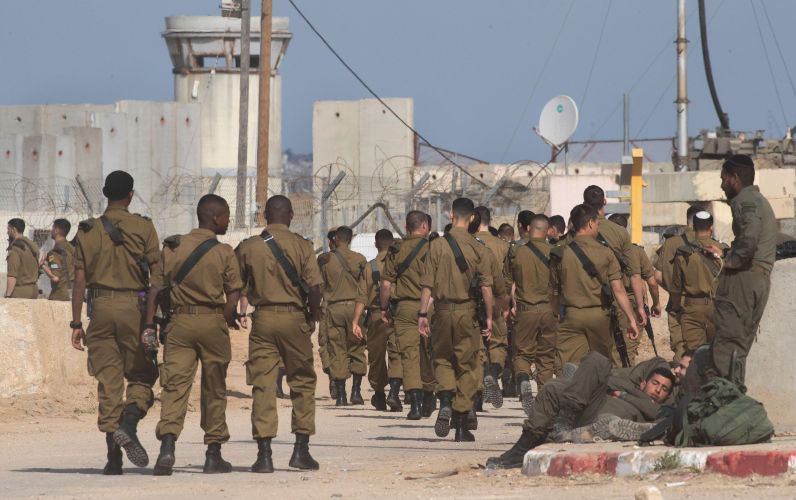Unsurprisingly, the vast majority of studies and literature on foreign fighters and the risks they pose to their home countries focuses on jihadis, with a smaller smattering of pieces on far-right individuals seeking combat experience in Ukraine.
However, many countries in the world will soon experience (if they aren’t already) the return of a different kind of foreign fighter – international volunteers with the Israel Defence Forces (IDF), known within the country as “lone soldiers”.
While these combatants are not commonly considered a security threat in the same class as other foreign fighters, I argue this may be a dangerous oversight. The facts are, these individuals are likely to be traumatised and desensitised from witnessing or committing acts of extreme violence, are militarily trained, and will be returning to an environment of much polarisation and hostility regarding their actions. It doesn’t take much imagination or even a particular ideological bent to identify these circumstances as a potential threat.
Foreign fighters and lone soldiers – what we know
While in the recent past, the subject has received great attention, the knowledge base on foreign fighters and what threats they represent remains incomplete. Most understanding of the issue comes from prominent cases involving jihadi fighters who have travelled from the West to fight in the Middle East. One of the few exceptions is a 2022 research article by Timrah Schmutz which fills an important gap by addressing Israel – a routine employer of foreign fighters/lone soldiers and the subject of much current debate.
The use of lone soldiers by Israel has a long history, with around 3500 taking part in the 1948 war, from 43 countries, but mostly from the US, Canada, South Africa and Western Europe. According to the Lone Soldier Center, there are currently more than 7000 lone soldiers in the IDF. Many of them are Israelis who have joined without family support, but about 45% are new immigrants from around the world.
Schmutz describes the interplay of the lone soldier’s background and environment on their identity. Many, around 60%, of those interviewed identified Judaism and Zionism as integral to their identity above all else. Others were not particularly religious, but drawn by key events such as the Gaza war. As such, these are not mercenaries or adventurers, but true believers in the IDF’s cause. Ultimately, Schmutz concludes in his study that while differences obviously exist between joining a state military or an insurgency, lone soldiers should be understood within the broader foreign fighter phenomenon.
The IDF in Gaza
To consider the lone soldier, abroad and upon return, it is necessary to soberly acknowledge what they may have witnessed or participated in while in Gaza. Recently, and with some impact, Amnesty International released a report highly critical of the IDF’s conduct in Gaza. On the level of specific soldiers and battalions, it was found that hundreds, possibly thousands, of Palestinians were subject to “acts of torture and other cruel, inhuman or degrading treatment”. It was also found that indiscriminate killing amounting to war crimes took place, and the IDF’s overall conduct could be credibly called genocide.
Similarly damning findings have been reported by Human Rights Watch and Médecins Sans Frontières. HRW found that Israel deliberately inflicted conditions upon Palestinians intended to result in their destruction (intent being determined by multiple statements from officials). Similarly, MSF found that actions such as mass killings and forced displacement were clear signs of ethnic cleansing.
Coming home
The point in this article, however, is not to prosecute the above arguments — this will no doubt be done extensively elsewhere — but to establish the social and mental environment a lone soldier has likely been exposed to, along with their military training, before returning home. At the same time, around the world, opposition and condemnation of Israel and the IDF is growing.
In America, the heartland of support for Israel and a necessary partner for its continuing military activities, public opinion is shifting. While many older Americans remain supportive of Israel, younger generations are increasingly against its actions in Gaza and beyond. The vast majority of Democrat voters oppose Israel, and while most Republicans are supportive, those numbers are falling.
Globally, Israel and Israelis are facing isolation as more and more states call for a cessation of their current activities. Developments such as the deaths of aid workers has contributed to the state’s growing pariah status. Domestically, Israel’s actions are becoming increasingly polarising with huge and ongoing protests.
Potential for extremism and violence
In such circumstances, the potential for extremist violence is heightened, though still uncertain. Several factors warrant particular attention. Firstly, returning lone soldiers are by definition militarily trained, rendering them more capable of inflicting harm than the average citizen. Secondly, there is reason to believe their experiences in Gaza may amount to trauma or desensitisation to extreme violence. Thirdly, upon a lone soldier’s return, not only are they trained for violence and inured to it, but they are likely to encounter hostility or antagonism in a polarised environment where many oppose what they have done and who they are.
With regards to potential radicalisation to violence, the military dimension is twofold: it is a truism that military extremism makes one better at violence and killing, but it may also contribute to other risk factors. In their study on extremism in the US military, Speckhard and Ellenberg observe that combat experiences in Afghanistan and Iraq led to the dehumanisation and othering of the enemy, and for some, by extension, all Muslims or Arabs. Further, in a study of far-right extremists with military experience, increased levels of trauma, social difficulties, mental illness, and grievance-based anger were seen.
While the link should not be overstated, mental health conditions such as post-traumatic stress disorder are known to contribute to receptivity to violent extremism. Among the more common links found is moral injury, wherein values and morals are somehow violated. The link to desensitisation to violence and later acts of violence is less clear, but often occurs in the same environment that one may acquire a trauma condition.
Finally, social factors can play a part in radicalisation to violence, such as social cohesion which is at an all-time low in many places, especially Gaza. Relatedly, polarisation, which is definitely present in Gaza, is associated with extremism, as are experiences of discrimination, which rightly or wrongly, will be a reality for many lone soldiers.
As the conflict inevitably ends, or terms of service end, lone soldiers will return home. At least, in some regions, some may face accusations or charges of war crimes. Others will face a deeply divided public and experience immense hostility, perhaps appropriately. It is vital that governments and institutions understand and address this, as they would with any other foreign fighters.

Gerard Gill
Gerard Gill is a postdoctoral researcher in Australia focusing on violent extremism, particularly the far right and conspiracism.
